Multi-Scale Evaluation of Suzhou City’s Sustainable Development Level Based on the Sustainable Development Goals Framework
Abstract
1. Introduction
2. Materials and Methods
2.1. Study Area
2.2. Construction of the Index System
2.2.1. Principle of Construction
- (1)
- Comprehensive Principle. The comprehensive principle generally regards regional development as an organic whole or system and mainly focuses on the detailed identification of the similarities and differences between elements within the system. Under the guidance of this principle, it was not advisable or necessary to reflect all the elements involved in regional development in the sustainable development evaluation index system. This principle advocates comprehensively and specifically analyzing the potential underlying factors of sustainable development through comprehensive analysis in order to reveal the dominant factors and the possible limiting factors affecting sustainable development.
- (2)
- Principle of Genesis. Genesis is mainly about the origin and processes related to this origin. The principle of genesis primarily explores the internal factors of system development and focuses on the causes and processes of the development of things. According to this principle, when constructing a sustainable development evaluation index system, attention needs to be paid to factors of intergenerational fairness that involve time, and factors of regional differences that involve space.
- (3)
- Principle of Anticipation. Indicators cannot be selected in isolation from international, national, and local realities, and local feasible development goals should also be considered in the future.
- (4)
- Principle of Quantifiability. The elements within the sustainable development system feature temporal and spatial variation, which often presents characteristics of uncertainty, randomness and non-linearity. Although traditional qualitative analysis can reflect the relevant information of the sustainable development system to a certain extent, it is still insufficient to accurately assess the level of sustainable development in the region. The quantifiable principle requires that the indicators involved in sustainable development evaluation can be directly quantified or indirectly assigned. The quantified results of the indicators can be used for accurate analysis, comparison and evaluation of sustainable development systems, and then make up for the limitations shown by qualitative analysis.
2.2.2. Index System Framework
2.3. Definition of Evaluation Unit
2.4. Data Sources and Processing
2.4.1. Data Sources
2.4.2. Data Standardization
2.5. Methods
2.5.1. Entropy Method
- (1)
- Standardize the index values according to the direction of the positive and negative development of the indices;
- (2)
- Calculate the proportion of the jth index of the evaluated object i:
- (3)
- Calculate the information entropy value of the jth index:
- (4)
- Calculate the information entropy utility value of the jth index:
- (5)
- Calculate the weight of the jth index:
2.5.2. Comprehensive Evaluation of Sustainable Development
- (1)
- Determine the domain of discourse of the evaluated object and construct the set of participating factors, U. The single factor was expressed as = 1, 2, 3, …, m); if there were m indices, the set of participating factors could be expressed as U = {u1∣u2∣……∣um}.
- (2)
- Establish the evaluation set V. The domain of discourse of the evaluation level was determined as (j = 1, 2, …, n), and the level set was expressed as V = {v1∣v2∣……∣ }.
- (3)
- Determine the membership function and calculate the membership degree of each factor. Here, is the membership degree of the factor to , and the single moving speed evaluation set of the th moving speed could be expressed as = (ri1, ri2, …, ).
- (4)
- Construct a fuzzy relation matrix. Matrix R corresponds to the element in the ith row and the jth column, which represents the frequency distribution state of the th factor in the jth comment , and .
- (5)
- Determine the weight vector of the evaluation factor. The weight was determined by the entropy method, and the weights of the factors were combined into a set expressed as W= (w1, w2, …, wm). The element contained in the weight vector, W, denotes the membership degree for factor to be divided into a fuzzy set. The weight is the importance of each index, and the sum of the index weights is 1; that is, , wi ≥ 0 ( = 1,2, …, m).
- (6)
- Measure the level of sustainable development. Based on the results about the fuzzy membership, the indices were synthesized, with corresponding results expressed as vector B. The equation was as follows:
3. Results
3.1. Sustainable Development Level on Prefecture Scale
3.2. Sustainable Development Level on County Scale
3.3. Sustainable Development Level On Township Scale
4. Discussion
4.1. Prefecture Scale
4.2. County Scale
4.3. Township Scale
4.4. Policy Implications
5. Conclusions
Author Contributions
Funding
Acknowledgments
Conflicts of Interest
References
- Dawson, I.G.J. Assessing the Effects of Information about Global Population Growth on Risk Perceptions and Support for Mitigation and Prevention Strategies. Risk Anal. 2018, 38, 2222–2241. [Google Scholar] [CrossRef]
- Mousivand, A.; Arsanjani, J.J. Insights on the historical and emerging global land cover changes: The case of ESA-CCI-LC datasets. Appl. Geogr. 2019, 106, 82–92. [Google Scholar] [CrossRef]
- John, P.; Holdren, P.R.E. Human population and the global environment: Population growth, rising per capita material consumption and disruptive technologies have made civilization a global ecological force. Am. Sci. 1974, 62, 282–292. [Google Scholar]
- Rind, D. Complexity and Climate. Science 1999, 284, 105–107. [Google Scholar] [CrossRef] [PubMed]
- Arrow, K.; Bolin, B.; Costanza, R.; Dasgupta, P.; Folke, C.; Holling, C.S.; Jansson, B.O.; Levin, S.; Mäler, K.G.; Perrings, C.; et al. Economic growth, carrying capacity, and the environment. Ecol. Econ. 1995, 15, 91–95. [Google Scholar] [CrossRef]
- Liu, Y.; Huang, X.; Yang, H.; Zhong, T. Environmental effects of land-use/cover change caused by urbanization and policies in Southwest China Karst area – A case study of Guiyang. Habitat Int. 2014, 44, 339–348. [Google Scholar] [CrossRef]
- Krank, S.; Wallbaum, H.; Grêt-Regamey, A. Perceived contribution of indicator systems to sustainable development in developing countries. Sustain. Dev. 2013, 21, 18–29. [Google Scholar] [CrossRef]
- Caiado, R.G.G.; Filho, W.L.; Quelhas, O.L.G.; Nascimento, D.L.D.M.; Ávila, L.V. A literature-based review on potentials and constraints in the implementation of the sustainable development goals. J. Clean. Prod. 2018, 198, 1276–1288. [Google Scholar] [CrossRef]
- Ward, M.; Possingham, H.; Rhodes, J.R.; Mumby, P. Food, money and lobsters: Valuing ecosystem services to align environmental management with Sustainable Development Goals. Ecosyst. Serv. 2018, 29, 56–69. [Google Scholar] [CrossRef]
- Hansen, J.; Jones, J. A systems framework for characterizing farm sustainability. Agric. Syst. 1996, 51, 185–201. [Google Scholar] [CrossRef]
- Kates, R.; Clark, W.C.; Al, E.; Hall, J.M.; Jaeger, C.; Lowe, I.; McCarthy, J.; Schellnhuber, H.J.; Bolin, B.; Dickson, N.M.; et al. Sustainability Science. SSRN Electron. J. 2001, 292, 641–642. [Google Scholar]
- Xiao, W.; Mills, J.; Guidi, G.; Rodriguez-Gonzalvez, P.; Barsanti, S.G.; González-Aguilera, D. Geoinformatics for the conservation and promotion of cultural heritage in support of the UN Sustainable Development Goals. ISPRS J. Photogramm. Remote. Sens. 2018, 142, 389–406. [Google Scholar] [CrossRef]
- Isan, M. Sustainable Development: Principles, Analysis and Policies; Parthenon Publication Group: New York, NY, USA, 1996. [Google Scholar]
- Susan, B.H. Environmental Planning and Sustainability; John Wiley & Sons: Hoboken, NJ, USA, 1996. [Google Scholar]
- Campbell, A.; Lurches, K.S. Core Competency-Based Strategy; International Thomson Business Press: New York, NY, USA, 1997. [Google Scholar]
- Brown, W.B. Building a Sustainable Society; Education Resources Information Center (ERIC): New York, NY, USA, 1981. [Google Scholar]
- Springmann, M.; Clark, M.; Mason-D’Croz, D.; Wiebe, K.; Bodirsky, B.L.; Lassaletta, L.; De Vries, W.; Vermeulen, S.J.; Herrero, M.; Carlson, K.M.; et al. Options for keeping the food system within environmental limits. Nature 2018, 562, 519–525. [Google Scholar] [CrossRef] [PubMed]
- Newbold, T.; Hudson, L.N.; Hill, S.L.L.; Contu, S.; Lysenko, I.; Senior, R.A.; Borger, L.; Bennett, D.J.; Choimes, A.; Collen, B.; et al. Global effects of land use on local terrestrial biodiversity. Nature 2015, 520, 45–50. [Google Scholar] [CrossRef] [PubMed]
- Tilman, D.; Clark, M. Global diets link environmental sustainability and human health. Nature 2014, 515, 518–522. [Google Scholar] [CrossRef]
- Blumenberg, C.; Martins, R.C.; Costa, J.C.; Ricardo, L.I.C. Is Brazil going to achieve the road traffic deaths target? An analysis about the sustainable development goals. Inj. Prev. 2017, 24, 250–255. [Google Scholar] [CrossRef]
- Liu, J.; Hull, V.; Godfray, H.C.J.; Tilman, D.; Gleick, P.; Hoff, H.; Pahl-Wostl, C.; Xu, Z.; Chung, M.G.; Sun, J.; et al. Nexus approaches to global sustainable development. Nat. Sustain. 2018, 1, 466–476. [Google Scholar] [CrossRef]
- Bryan, B.A.; Gao, L.; Ye, Y.; Sun, X.; Connor, J.D.; Crossman, N.D.; Stafford-Smith, M.; Wu, J.; He, C.; Yu, D.; et al. China’s response to a national land-system sustainability emergency. Nature 2018, 559, 193–204. [Google Scholar] [CrossRef]
- Gao, L.; Bryan, B.A. Finding pathways to national-scale land-sector sustainability. Nature 2017, 544, 217–222. [Google Scholar] [CrossRef]
- Mann, C.; Garcia-Martin, M.; Raymond, C.M.; Shaw, B.J.; Plieninger, T. The potential for integrated landscape management to fulfil Europe’s commitments to the Sustainable Development Goals. Landsc. Urban Plan. 2018, 177, 75–82. [Google Scholar] [CrossRef]
- Giupponi, C.; Gain, A.K. Integrated spatial assessment of the water, energy and food dimensions of the sustainable development goals. Reg. Environ. Change 2017, 17, 1881–1893. [Google Scholar] [CrossRef]
- Renard, D.; Rhemtulla, J.M.; Bennett, E.M. Historical dynamics in ecosystem service bundles. Proc. Natl. Acad. Sci. USA 2015, 112, 13411–13416. [Google Scholar] [CrossRef]
- Maes, J.; Paracchini, M.; Zulian, G.; Dunbar, M.; Alkemade, R. Synergies and trade-offs between ecosystem service supply, biodiversity, and habitat conservation status in Europe. Boil. Conserv. 2012, 155, 1–12. [Google Scholar] [CrossRef]
- Khosla, A. Science and technology for sustainable development. Curr. Sci. 1999, 76, 1080–1086. [Google Scholar]
- Hart, M. Guide to Sustainable Community Indicators, 2nd ed.; Hart Environmental Data: North Andover, MA, USA, 1999. [Google Scholar]
- Chen, J.; Wang, Y.; Li, F.; Liu, Z. Aquatic ecosystem health assessment of a typical sub-basin of the Liao River based on entropy weights and a fuzzy comprehensive evaluation method. Sci. Rep. 2019, 9, 14045. [Google Scholar] [CrossRef]
- Yang, B.; Xu, T.; Shi, L.Y. Analysis on sustainable urban development levels and trends in China’s cities. J. Clean. Prod. 2017, 141, 868–880. [Google Scholar] [CrossRef]
- Cao, Z.L. The construction and evaluation of regional agricultural sustainable development index system- a case study of Hengyang city. Econ. Geogr. 2012, 32, 113–116. [Google Scholar]
- Schmidt-Traub, G.; Kroll, C.; Teksoz, K.; Durand-Delacre, D.; Sachs, J.D. National baselines for the Sustainable Development Goals assessed in the SDG Index and Dashboards. Nat. Geosci. 2017, 10, 547–555. [Google Scholar] [CrossRef]
- Sidorchuk, I.; Akhrymenka, A.; Shmakova, O.; Grigoriev, A.; Parfenchyk, A.; Kulai, O. Implementing sustainable development on the regional level in belarus. Eur. J. Sustain. Dev. 2017, 6, 435–443. [Google Scholar] [CrossRef]
- Su, Y.; An, X.L. Application of threshold regression analysis to study the impact of regional technological innovation level on sustainable development. Renew. Sustain. Energ. Rev. 2018, 89, 27–32. [Google Scholar]
- Sepehri, M.; Malekinezhad, H.; Hosseini, S.Z.; Ildoromi, A.R. Assessment of flood hazard mapping in urban areas using entropy weighting method: a case study in Hamadan city, Iran. Acta Geophys. 2019, 67, 1435–1449. [Google Scholar] [CrossRef]
- Singh, V. The use of entropy in hydrology and water resources. Hydrol. Process. 1997, 11, 587–626. [Google Scholar] [CrossRef]
- Liu, L.; Zhou, J.; An, X.; Zhang, Y.; Yang, L. Using fuzzy theory and information entropy for water quality assessment in Three Gorges region, China. Expert Syst. Appl. 2010, 37, 2517–2521. [Google Scholar] [CrossRef]
- Xu, H.; Ma, C.; Lian, J.; Xu, K.; Chaima, E. Urban flooding risk assessment based on an integrated k-means cluster algorithm and improved entropy weight method in the region of Haikou, China. J. Hydrol. 2018, 563, 975–986. [Google Scholar] [CrossRef]
- Chen, X.; Liu, X.; Hu, D. Assessment of sustainable development: A case study of Wuhan as a pilot city in China. Ecol. Indic. 2015, 50, 206–214. [Google Scholar] [CrossRef]
- Xue, X.H.; Yang, X.G. Seismic liquefaction potential assessed by fuzzy comprehensive evaluation method. Nat. Hazards 2014, 71, 2101–2112. [Google Scholar] [CrossRef]
- Zhang, W.; Lu, J.; Zhang, Y. Comprehensive Evaluation Index System of Low Carbon Road Transport Based on Fuzzy Evaluation Method. Procedia Eng. 2016, 137, 659–668. [Google Scholar] [CrossRef]
- Xiaoyu, L.; Jian, G.; Fei, C.; Hokao, K. Residential Environment Evaluation Model and Residential Preferences of the Changjiang Delta Region of China. J. Asian Arch. Build. Eng. 2007, 6, 299–306. [Google Scholar] [CrossRef]
- Chen, W.; Sun, W.; Duan, X.J.; Chen, J.L. Regionalization of regional potential development in Suzhou city. Acta Geogr. Sin. 2006, 61, 839–846. [Google Scholar]
- Liang, S.; Zhang, T. Urban Metabolism in China Achieving Dematerialization and Decarbonization in Suzhou. J. Ind. Ecol. 2011, 15, 420–434. [Google Scholar] [CrossRef]
- Bao, Z.; Lu, W.; Chi, B.; Yuan, H.; Hao, J. Procurement innovation for a circular economy of construction and demolition waste: Lessons learnt from Suzhou, China. Waste Manag. 2019, 99, 12–21. [Google Scholar] [CrossRef] [PubMed]
- Chen, C.; Pei, S.; Jiao, J. Land subsidence caused by groundwater exploitation in Suzhou City, China. Hydrogeol. J. 2003, 11, 275–287. [Google Scholar] [CrossRef]
- Chou, T.-L.; Chang, J.-Y.; Li, T.-C. Government Support, FDI Clustering and Semiconductor Sustainability in China: Case Studies of Shanghai, Suzhou and Wuxi in the Yangtze Delta. Sustainability 2014, 6, 5655–5681. [Google Scholar] [CrossRef]
- Mo, H.P.; Wen, Z.G.; Chen, J.N. China’s recyclable resources recycling system and policy: a case study in Suzhou. Resour. Conserv. Recycl. 2009, 53, 409–419. [Google Scholar] [CrossRef]
- Zhu, W.J.; Sun, H. Dynamic Measurement and Obstacle Tracking Analysis of Land Use Efficiency in Suzhou from 2000 to 2015. Chin. J. Soil Sci. 2019, 50, 290–297. [Google Scholar]
- Dennis Wei, Y.H.; Lu, Y.Q.; Chen, W. Globalizing regional development in Sunan, China: Does Suzhou industrial park fit a Neo-Marshallian District model? Reg. Stud. 2009, 43, 409–427. [Google Scholar] [CrossRef]
- Wang, C.L. Research on planning strategies of the mixed land use of the ancient city of Suzhou based on protection. J. Suzhou Univ. Sci. Technol. (Eng. Technol.) 2015, 28, 58–64. [Google Scholar]
- Wang, Y.; Wu, G.P.; He, L.Y. Analysis and simulation for landscape pattern changes of land use in Wuzhong district, Suzhou city. J. Landsc. Res. 2010, 2, 39–42. [Google Scholar]
- Qiao, W.F.; Sun, Z.H.; Shao, F.R.; Ni, T.; Feng, S.S.; Zhang, G. Analysis on evolution and driving factors of land use structure in highly urbanized area. Res. Environ. Yangtze Basin 2012, 21, 557–564. [Google Scholar]
- Gu, H.F. Finance supporting strategy of industry structure optimization from region perspective—based on Suzhou city. Econ. Geogr. 2010, 30, 790–794. [Google Scholar]
- Wang, Y.C.; Miller, P.; Katen, B. The traditionality evaluation of culture landscape space and its holistic conservation pattern: a case study of Qiandeng-Zhangpu Region in Jiangsu Province. Acta. Geogr. Sinica. 2011, 66, 525–534. [Google Scholar]
- Xu, H.L.; Gao, W.L.; Chen, S.; Chen, D.C. Identification of urban ecological space in South Jiangsu based on GIS: a case study of Suzhou. Chin. J. Ecol. 2019, in press. [Google Scholar] [CrossRef]
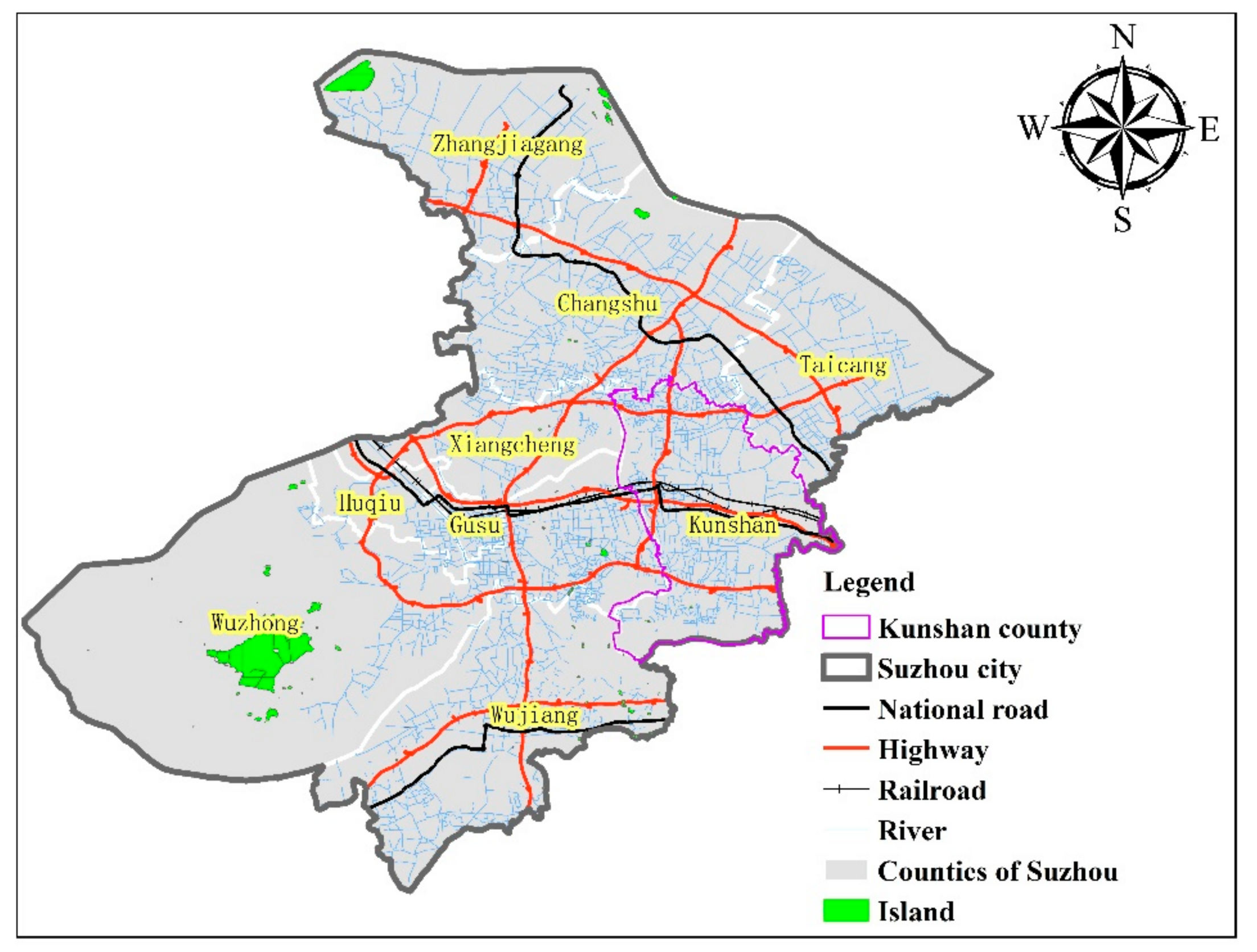
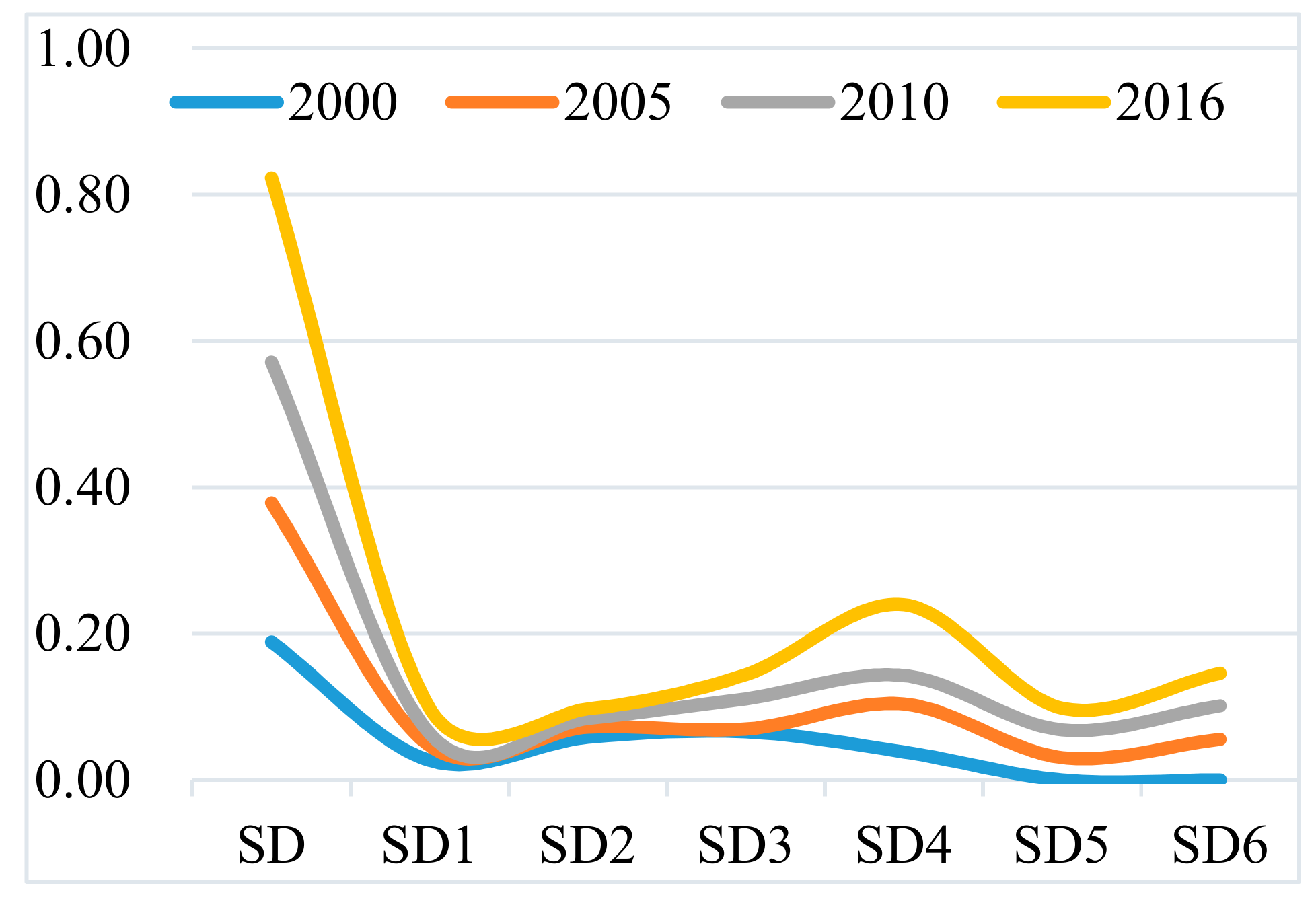
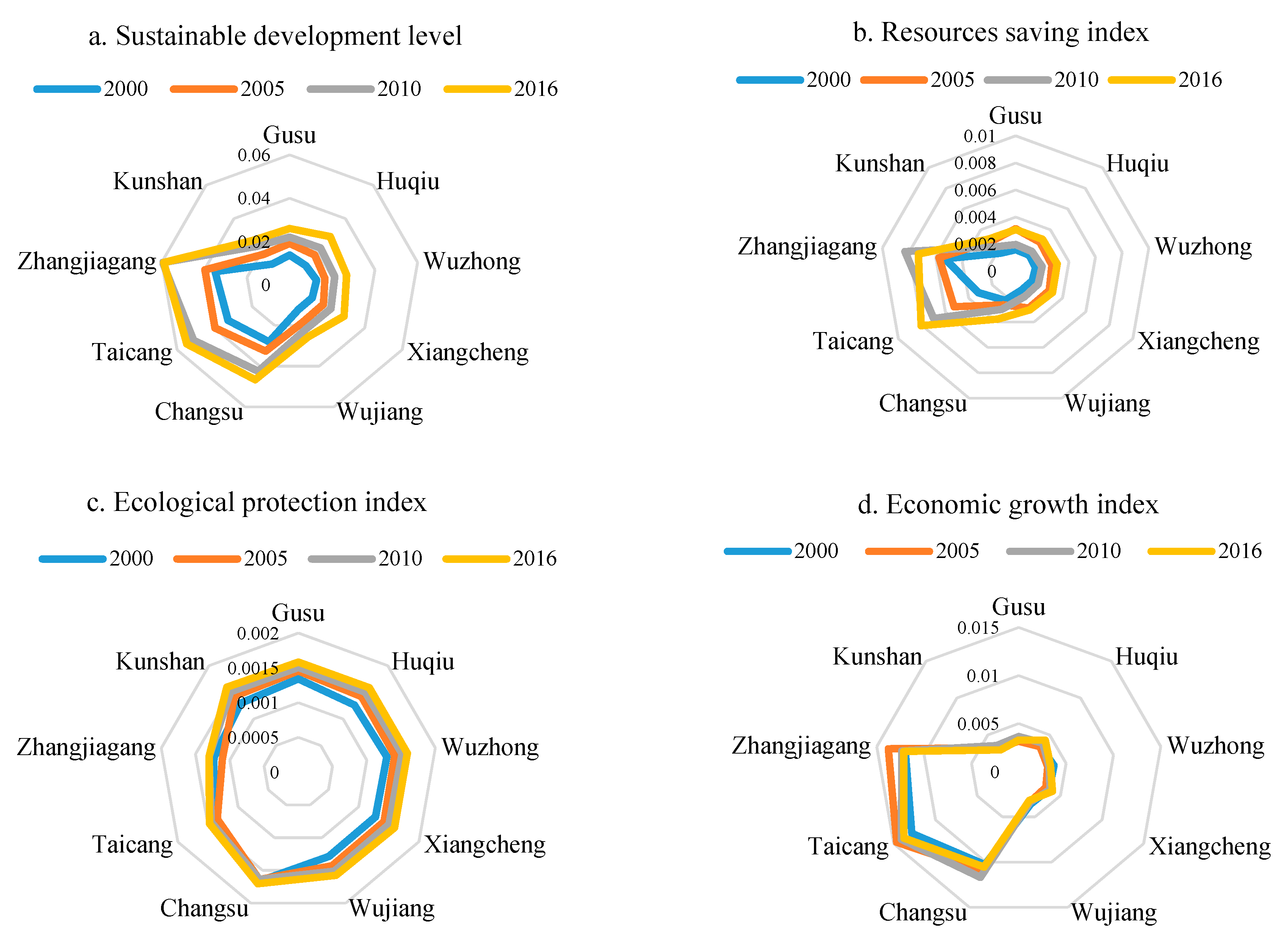
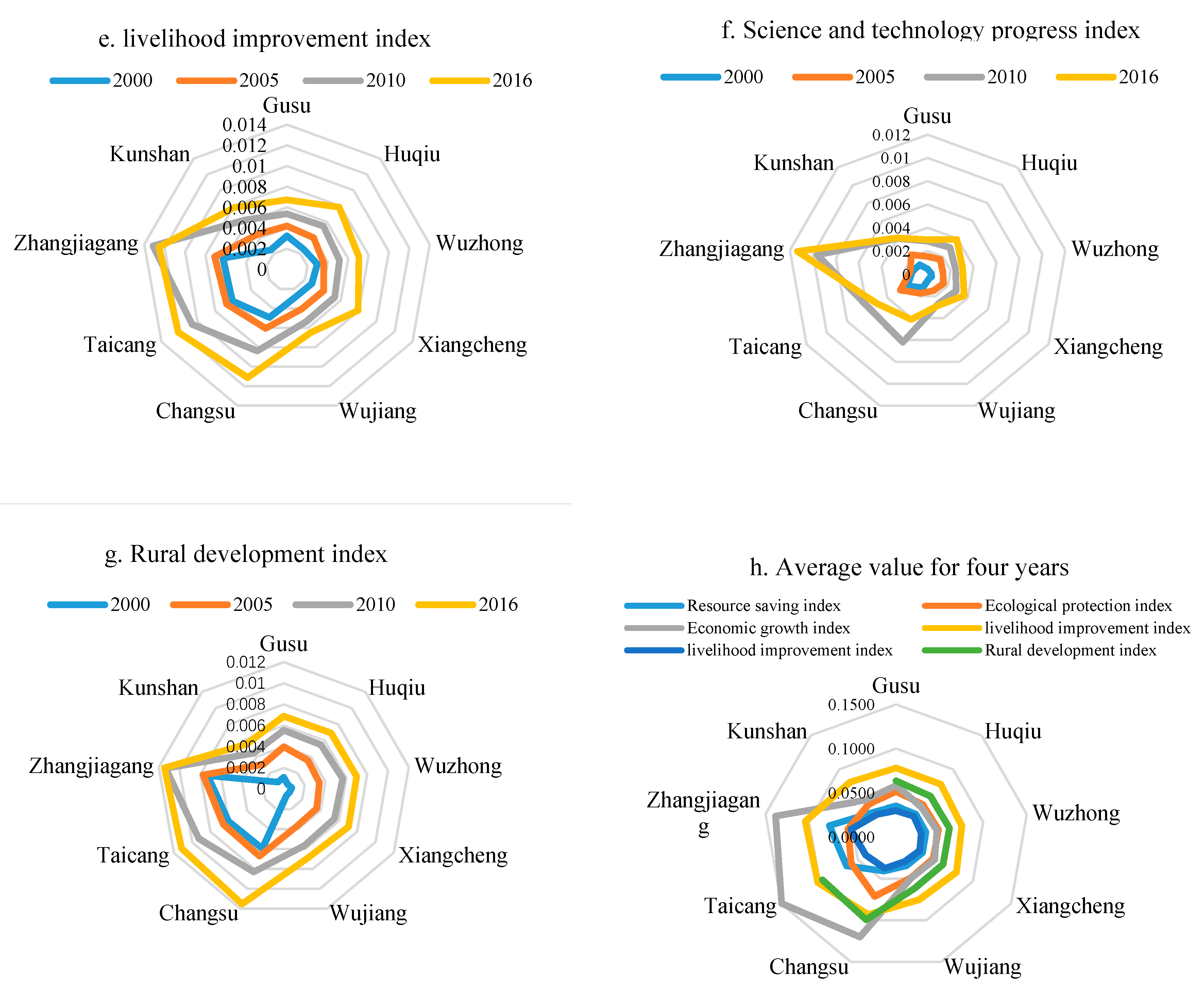
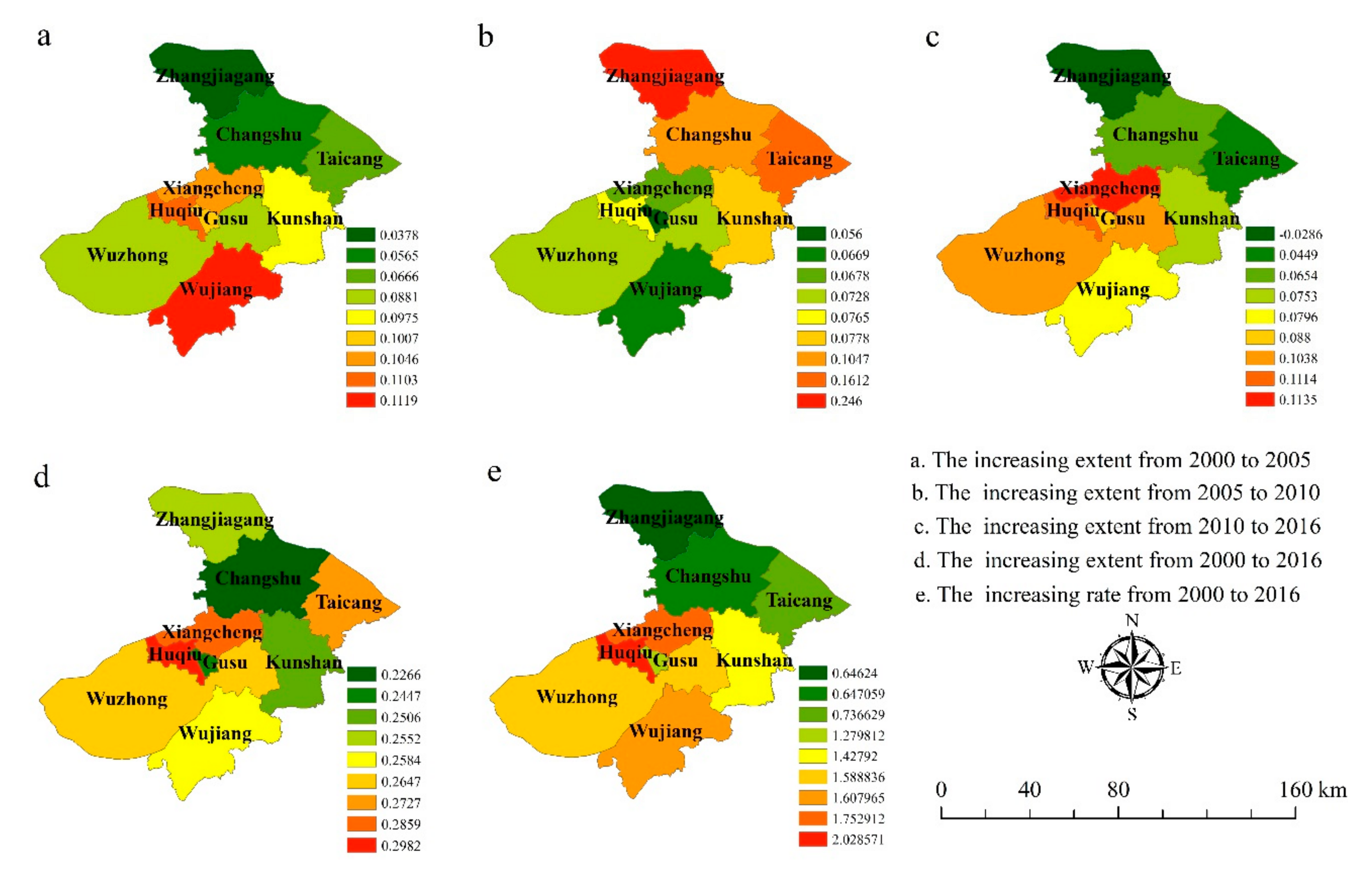
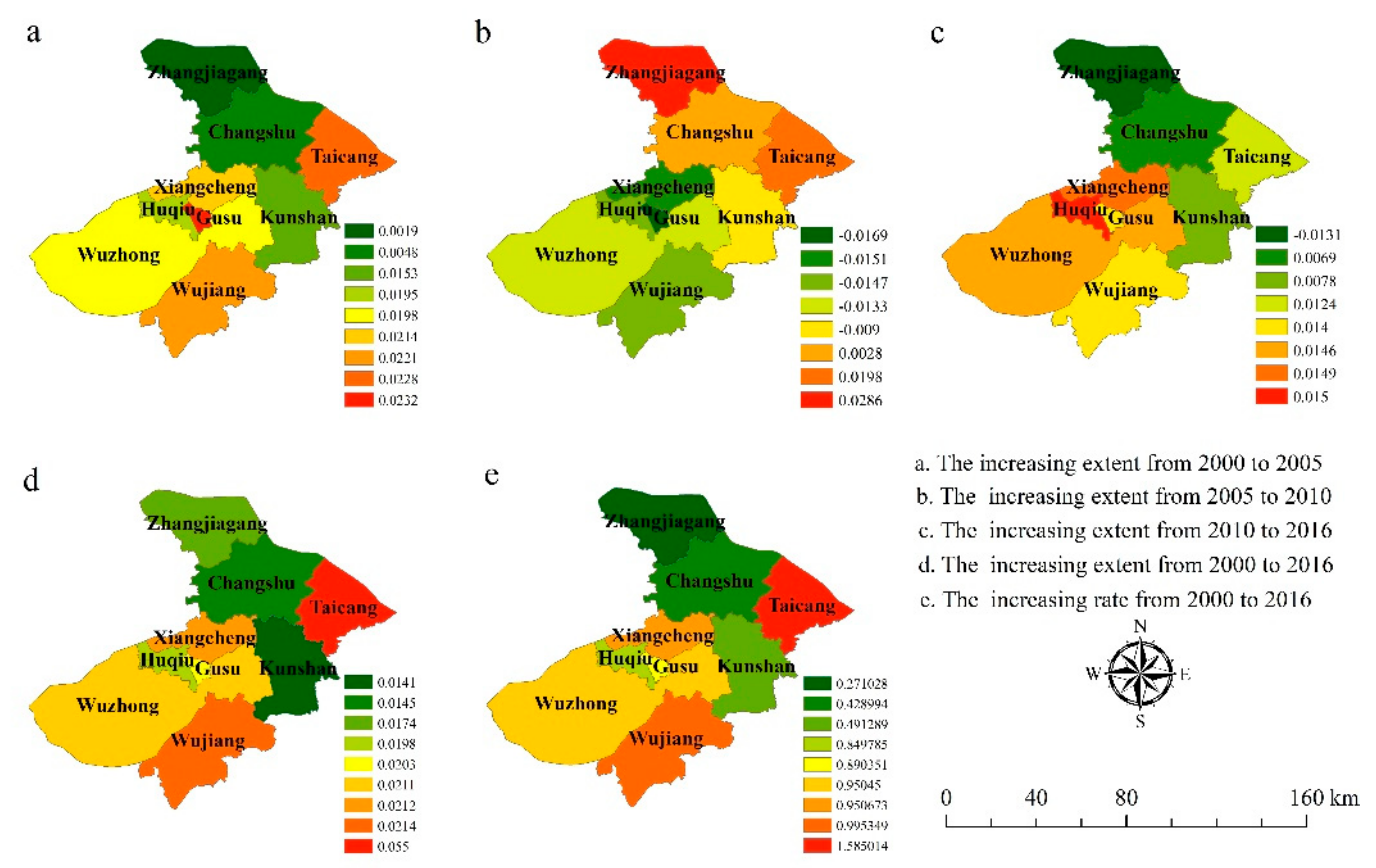
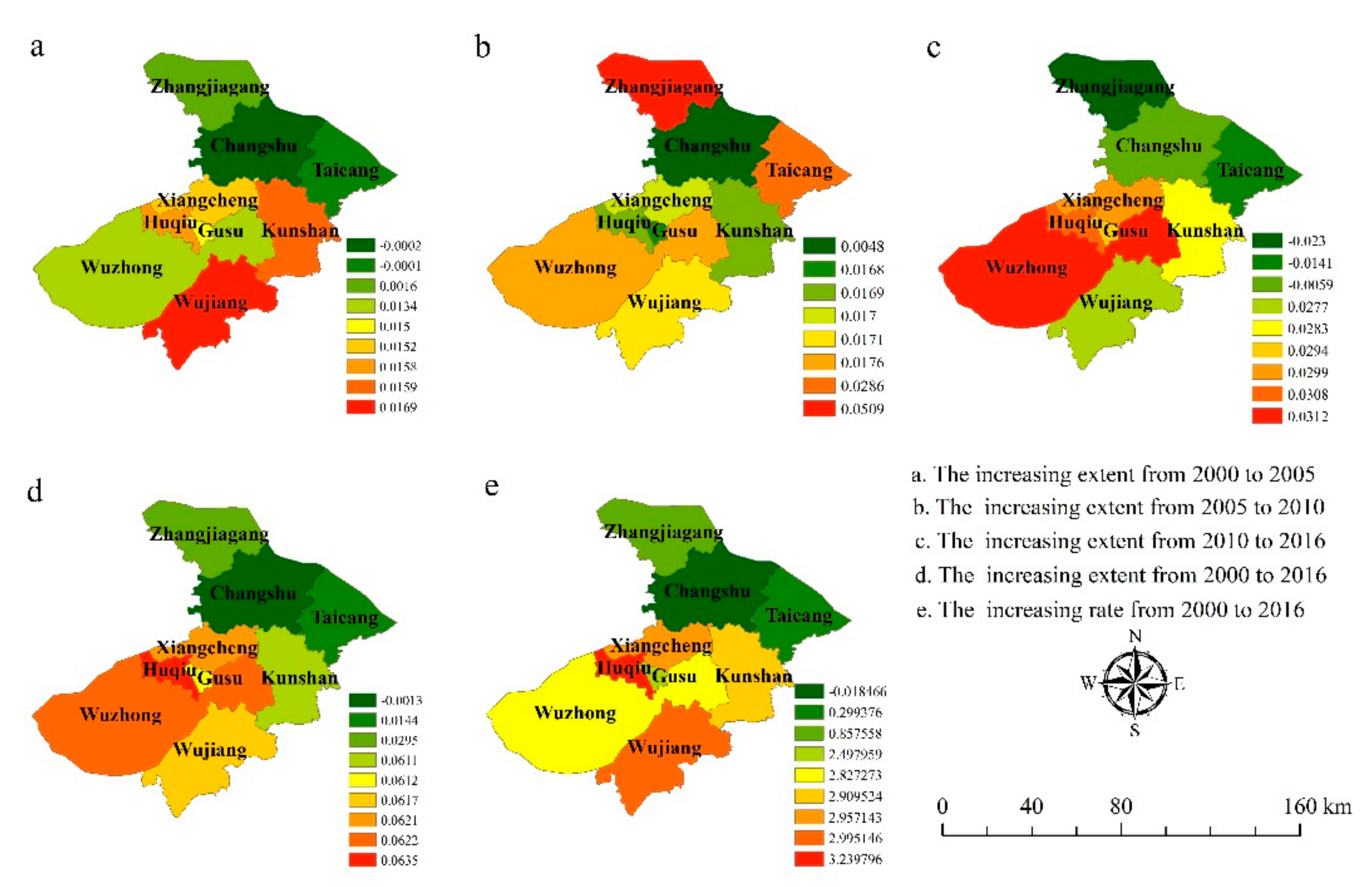
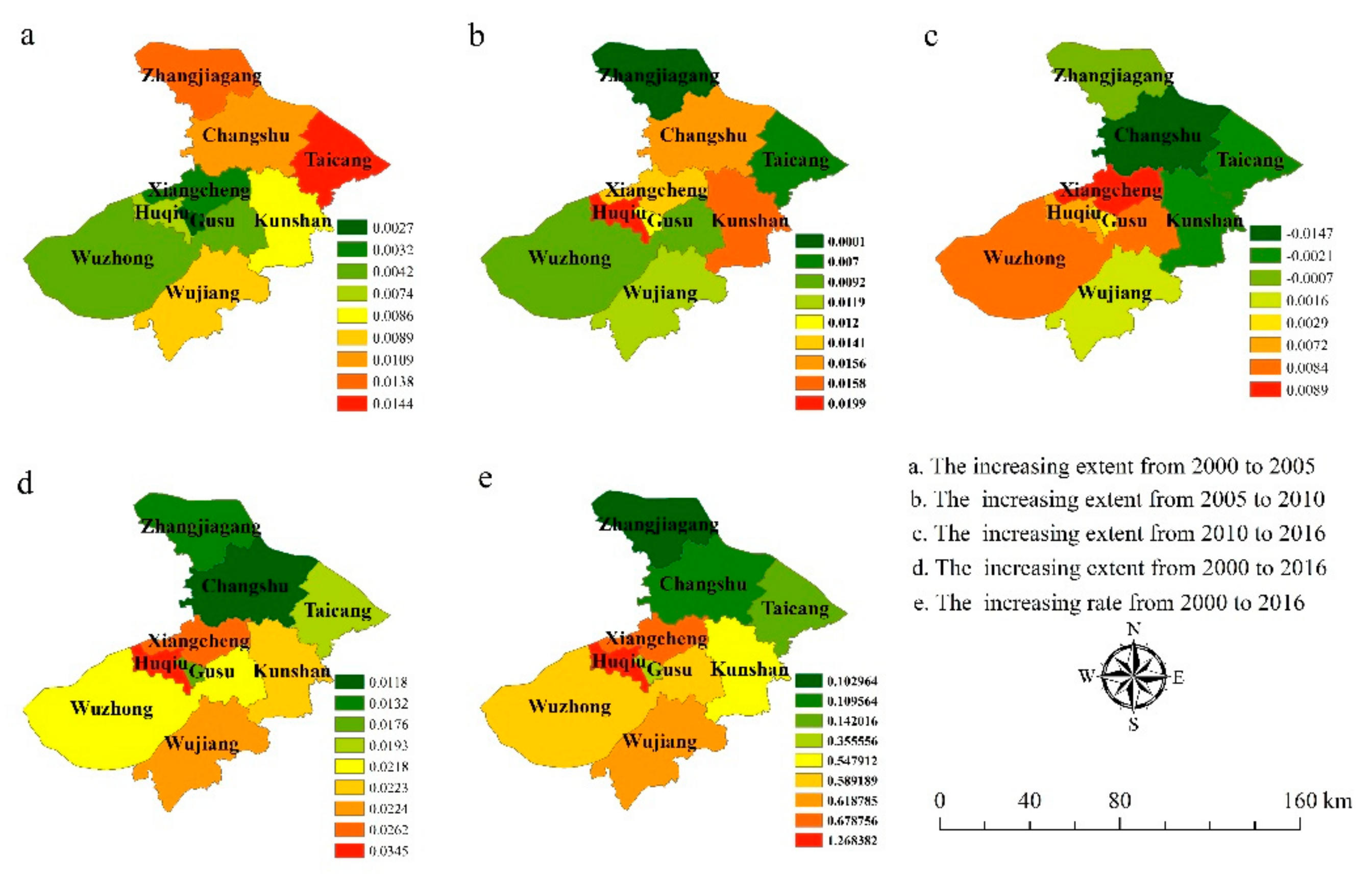
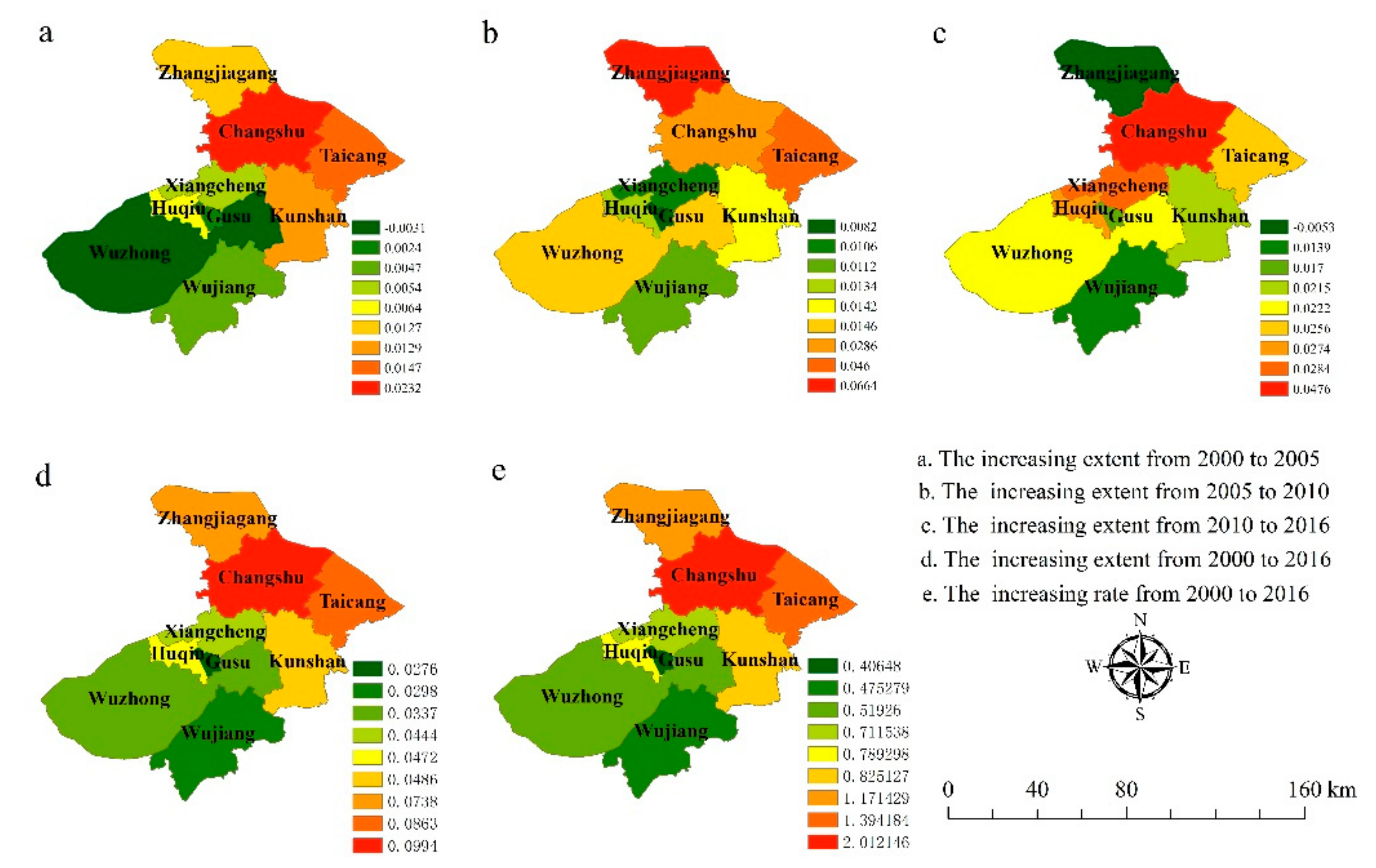
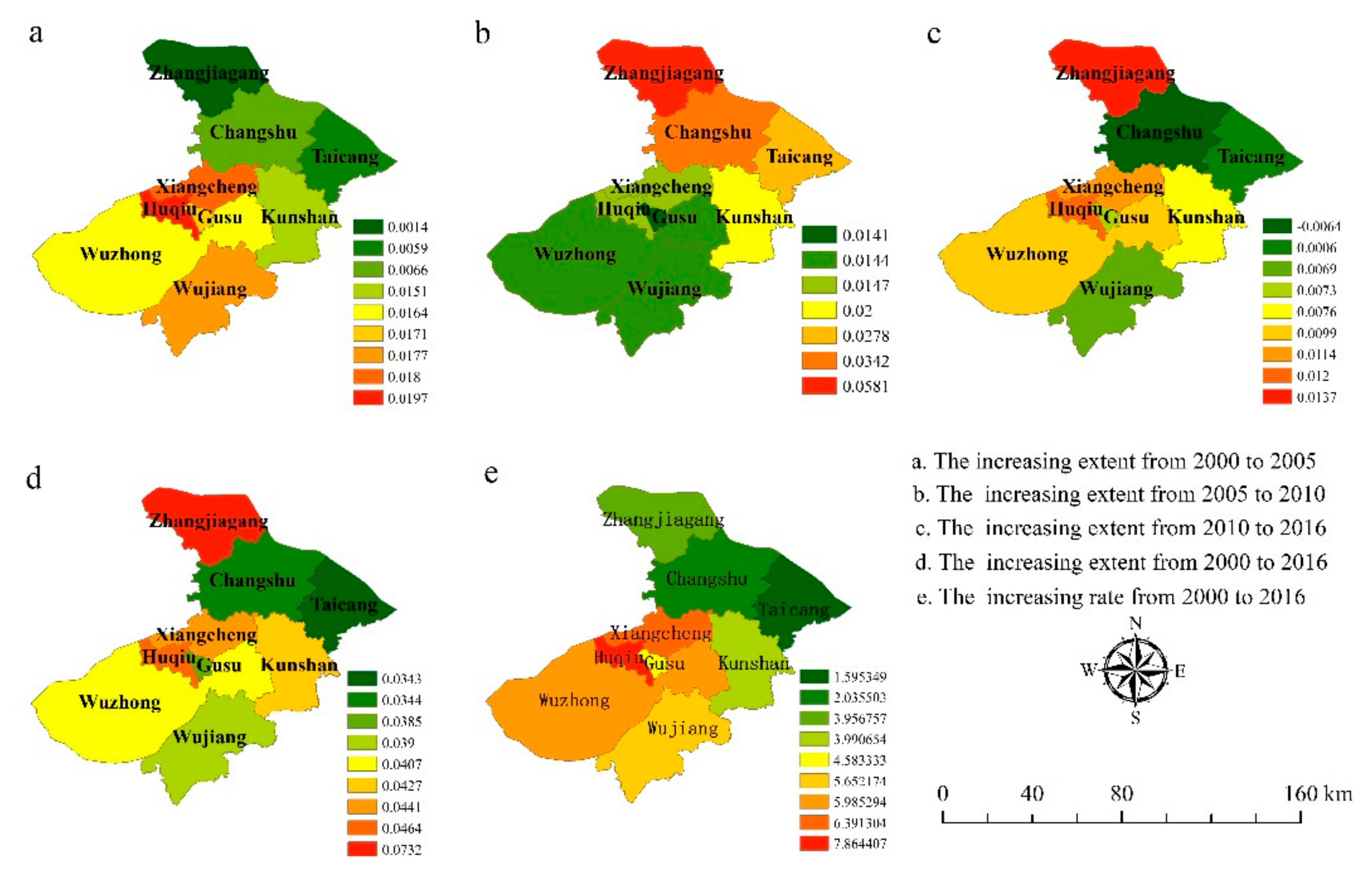
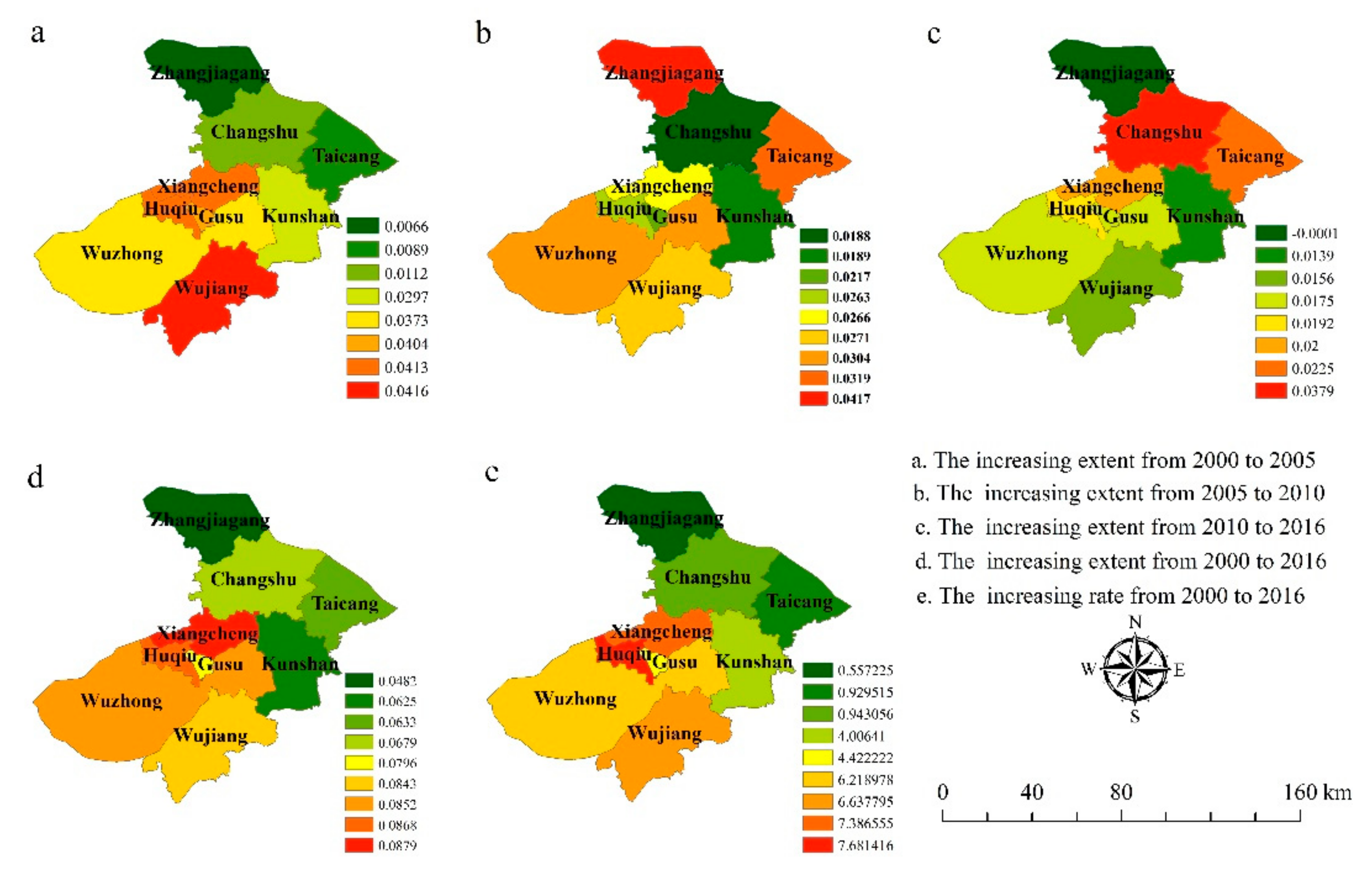
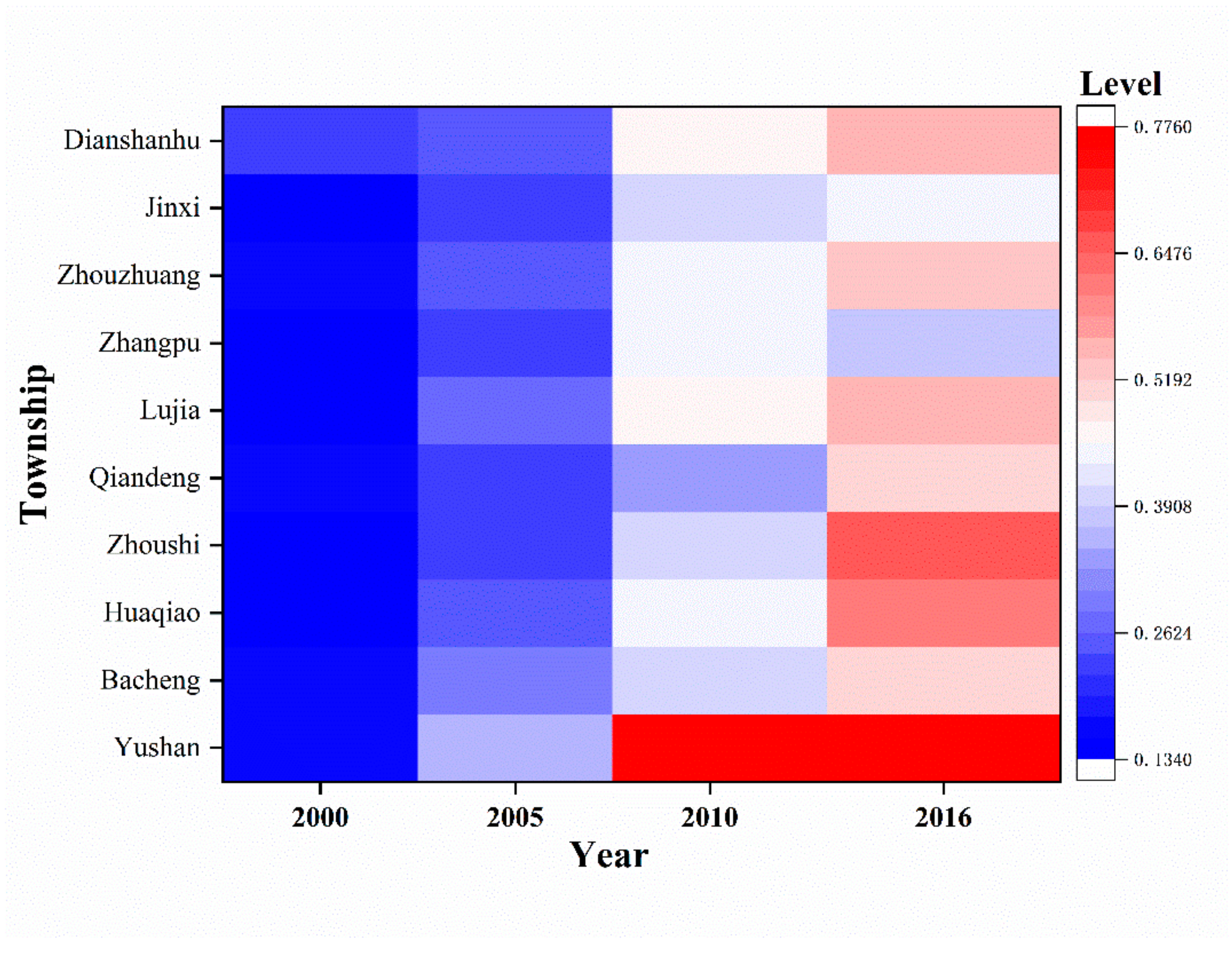
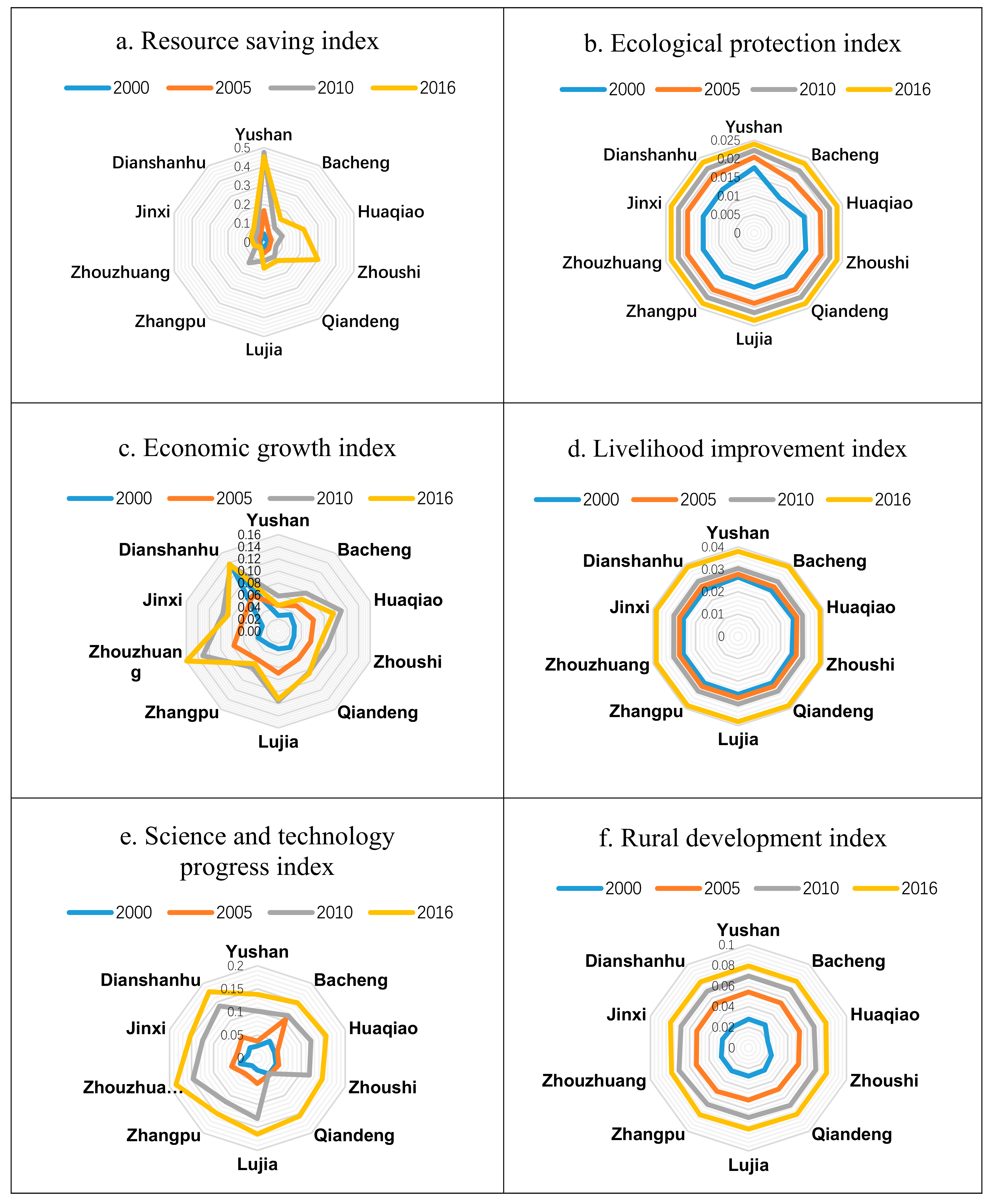
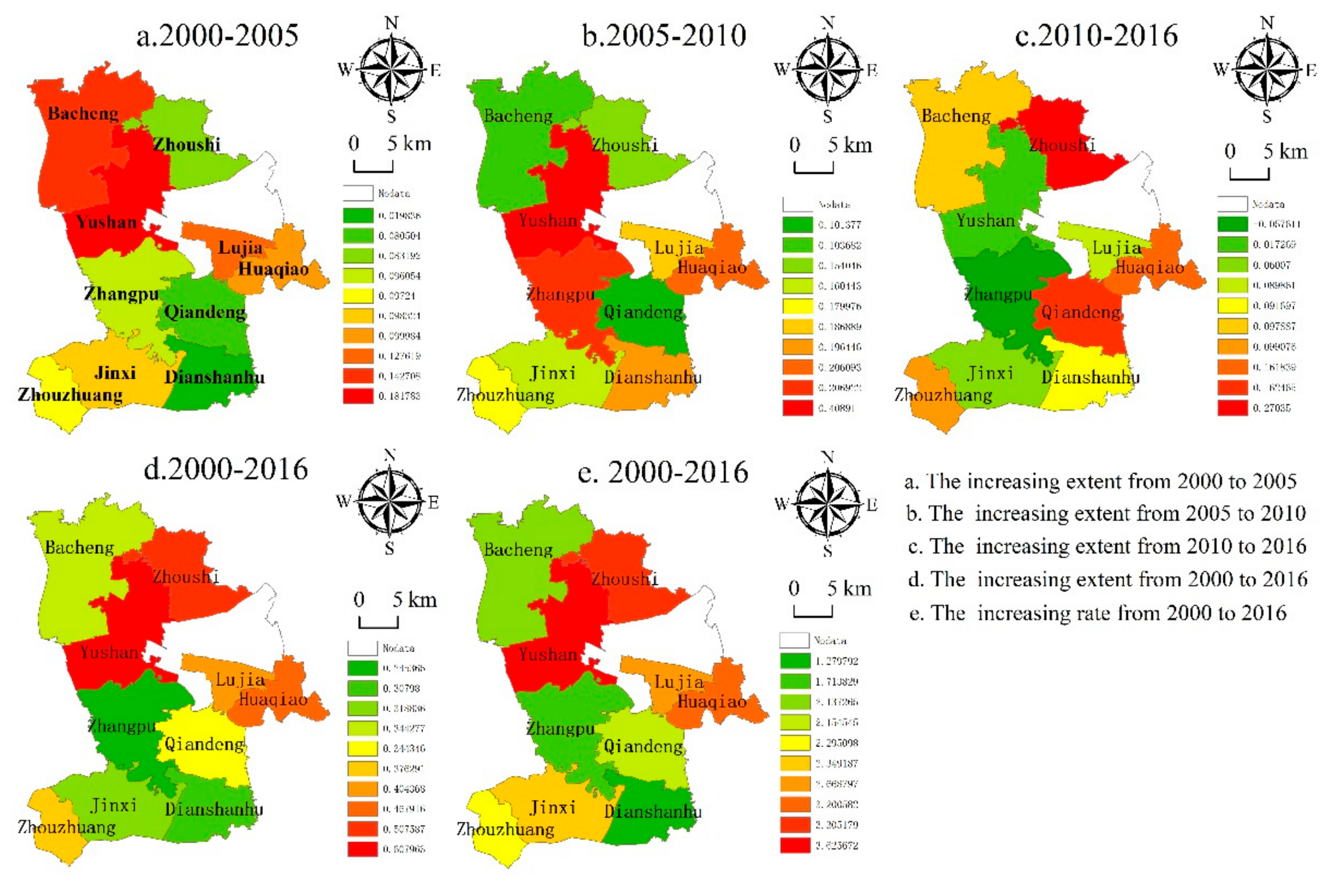
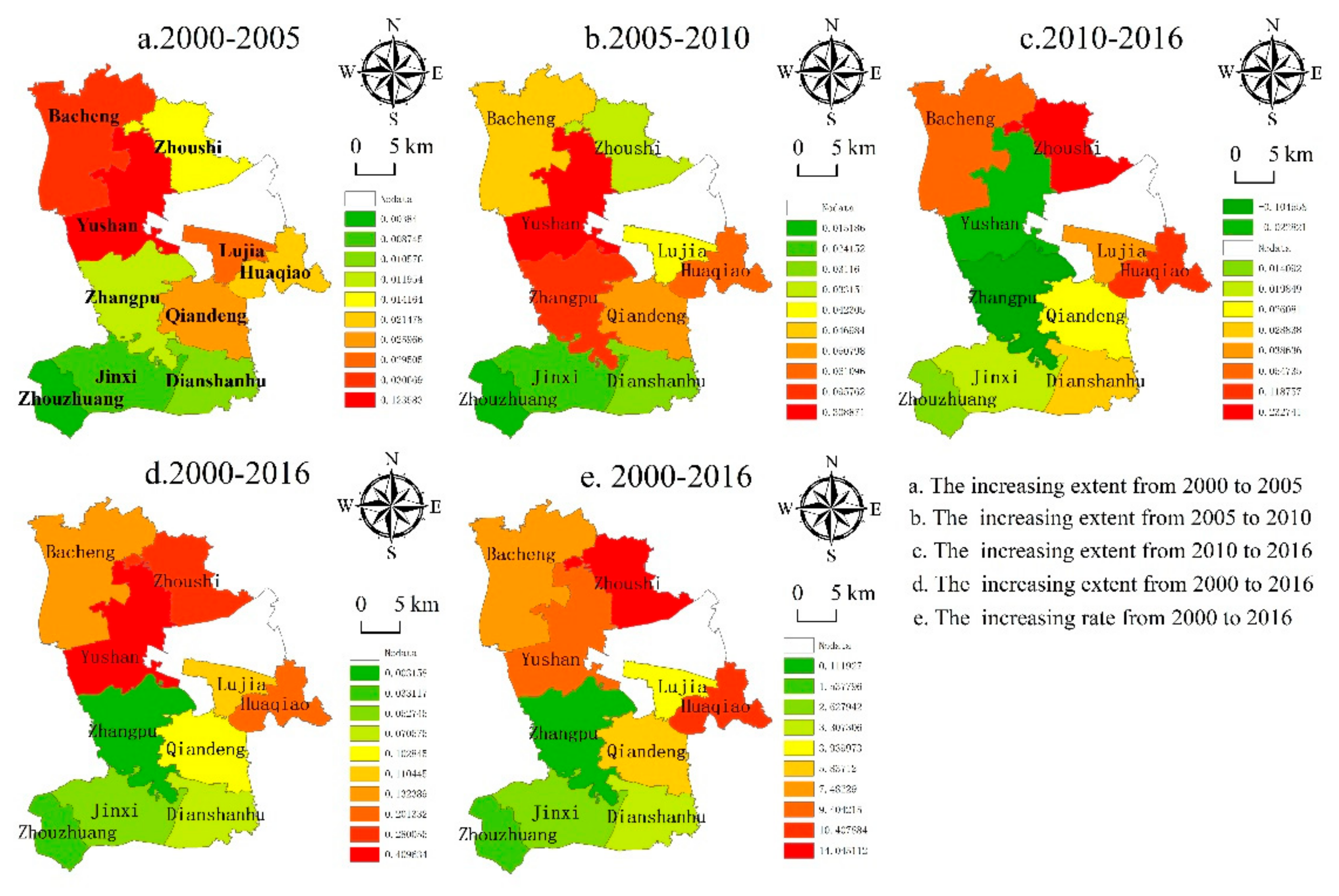
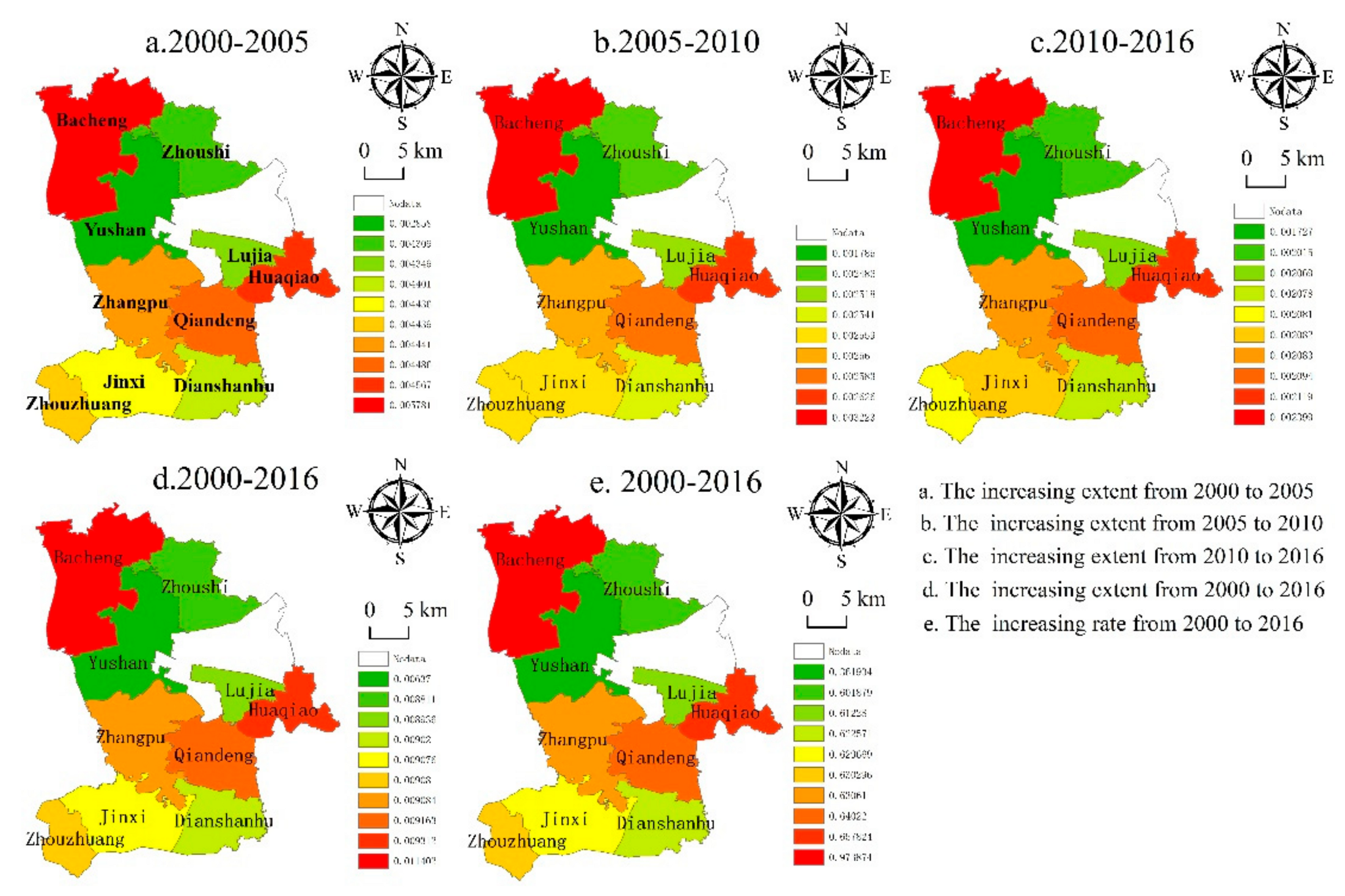
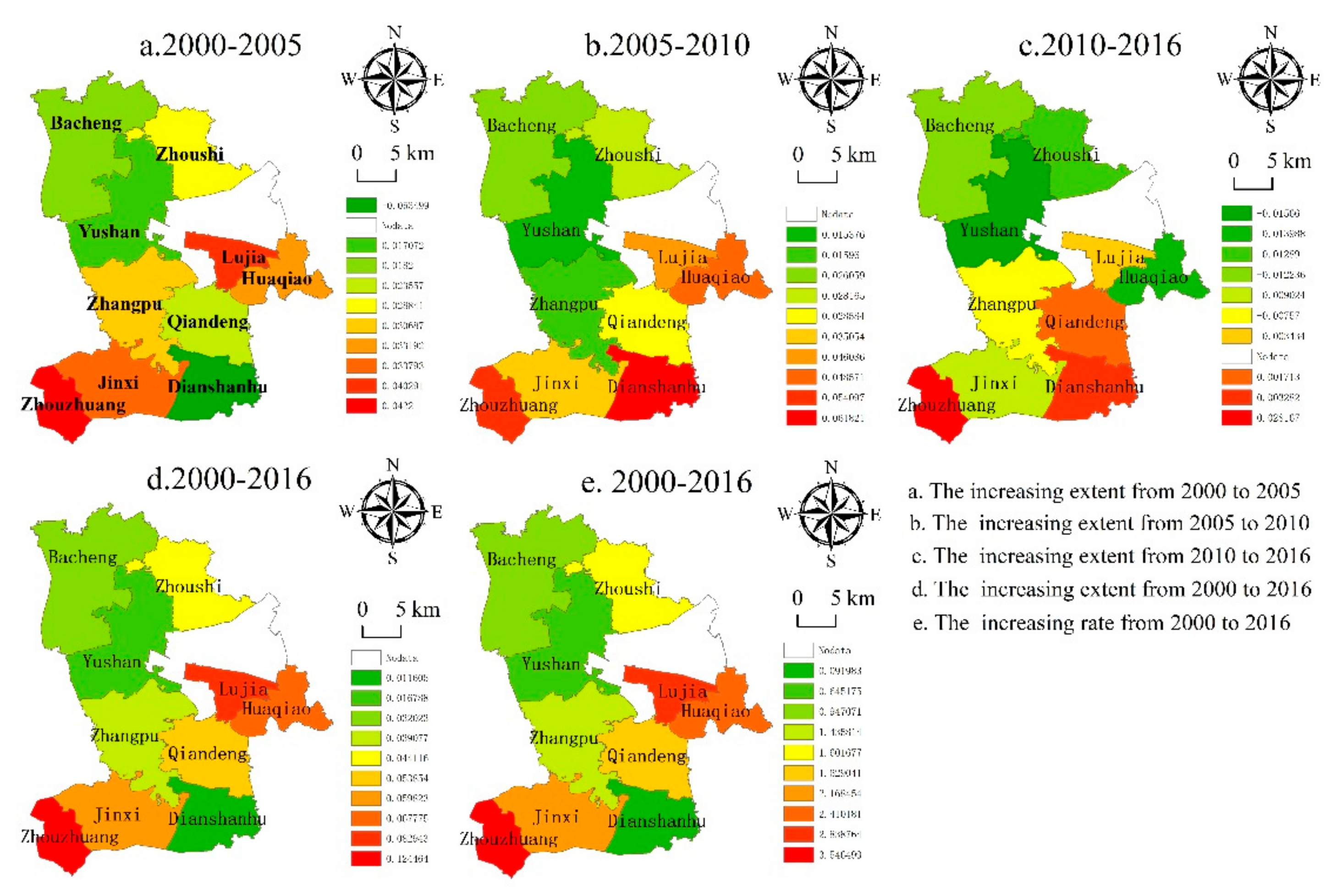
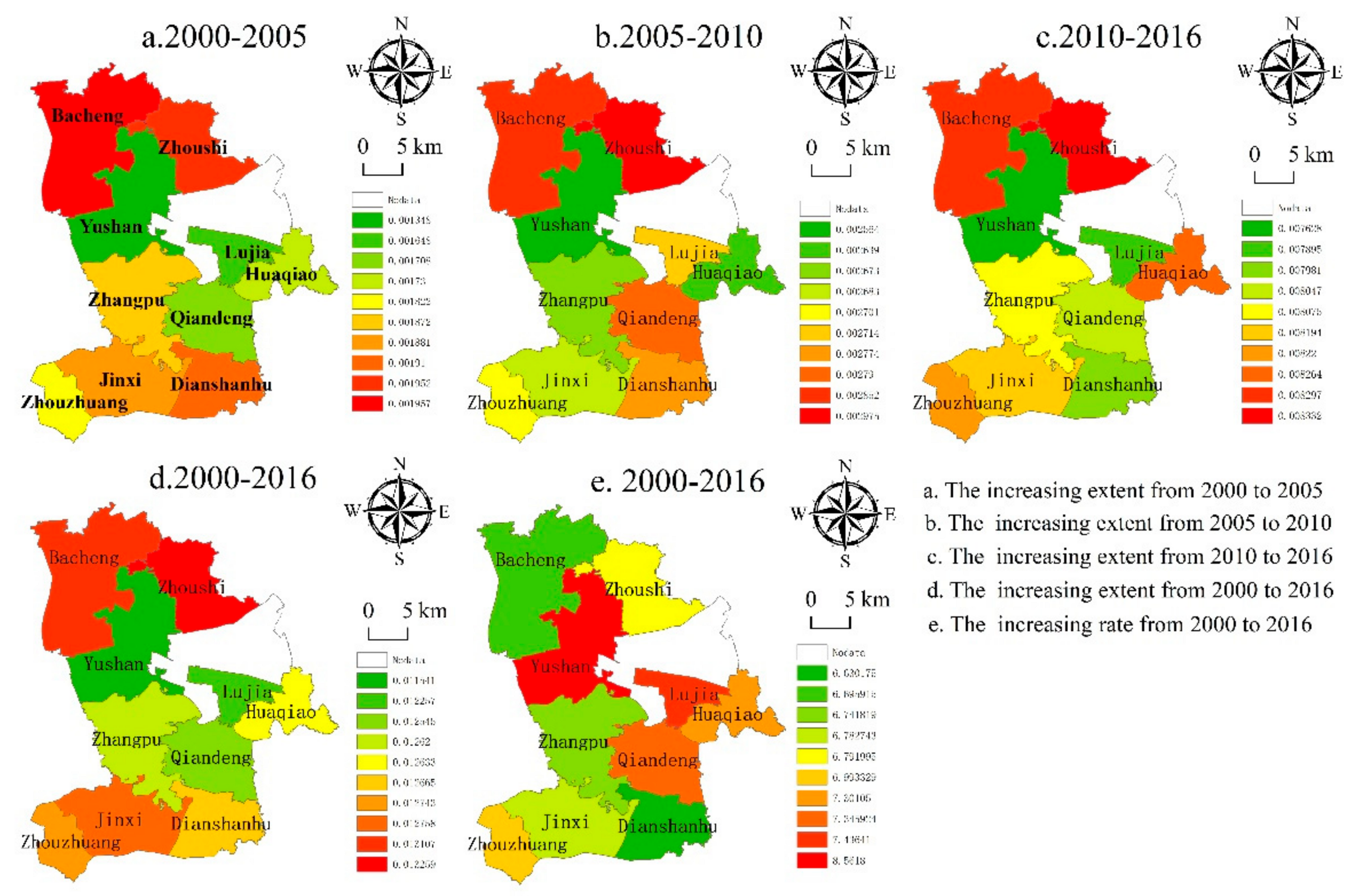
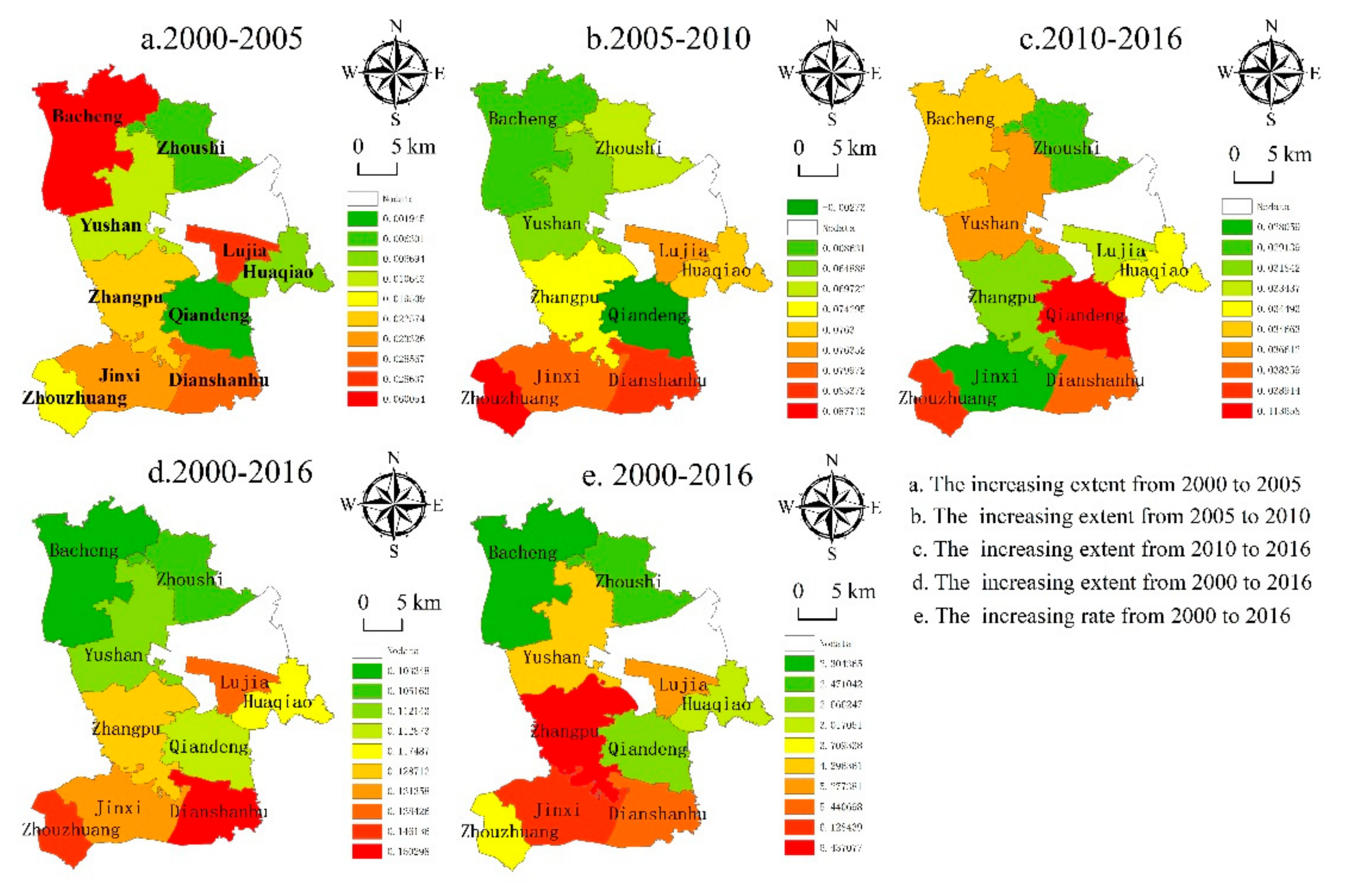
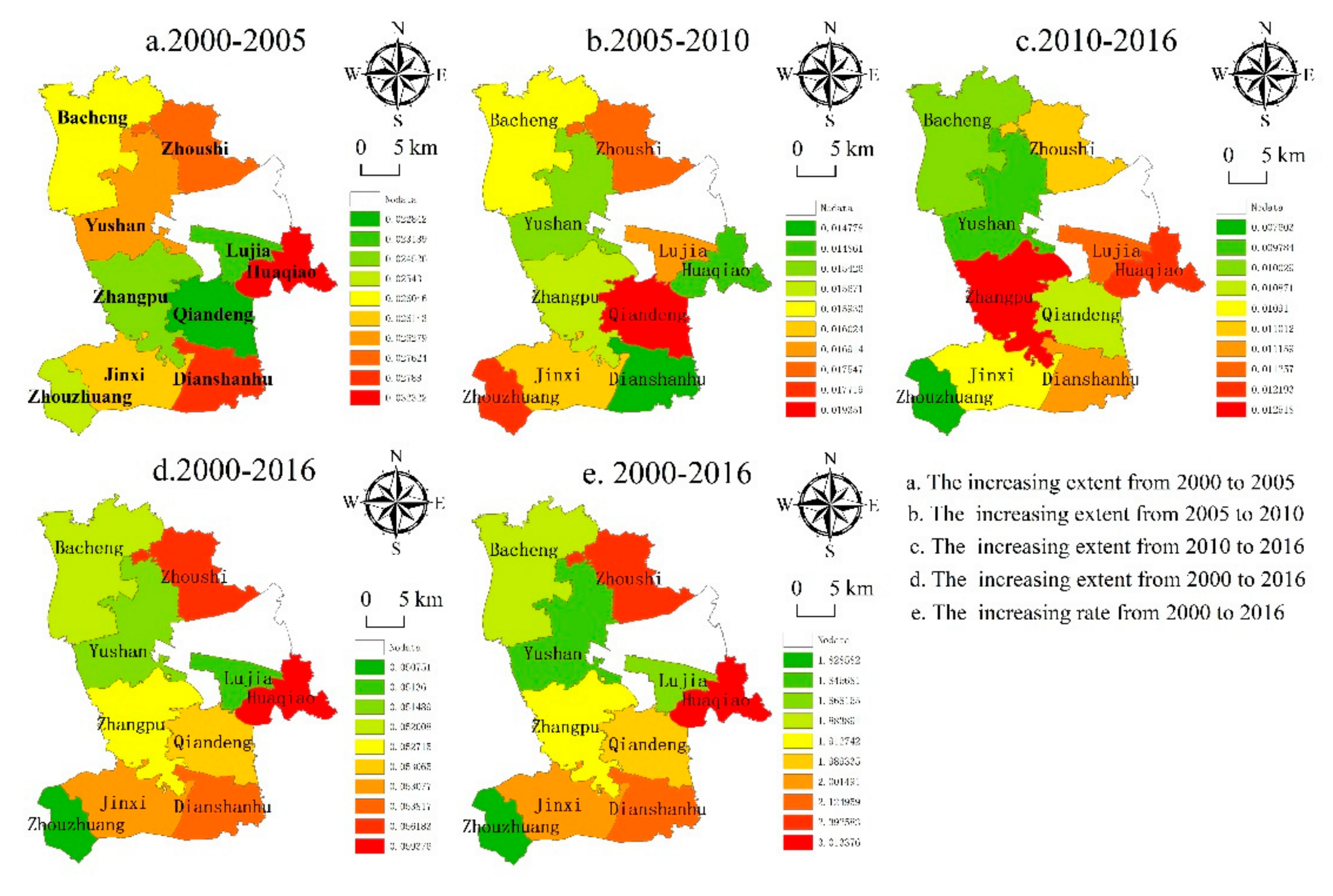
| Subsystem | Index |
|---|---|
| Resource conservation index | Water consumption per 10,000 yuan of GDP, electricity consumption per 10,000 yuan of GDP, standard coal consumption per 10,000 yuan of GDP, GDP per acre, waste recycling rate, and ratio of construction land growth rate to urban population growth rate |
| Ecological protection index | Wastewater standard compliance rate, water function compliance rate, water surface rate, ratio of ecological protection and environmental treatment industry to GDP in fixed assets investment, greening rate of urban built-up area, proportion of hazardous waste treatment, proportion of non-fossil energy consumption to primary energy consumption, the proportion of days when PM2.5 reached the standard in towns, and the annual decline rate of greenhouse gas emissions |
| Economic growth index | Per capita amount of investment in fixed assets, amount of foreign direct investment, proportion of tertiary industry output in GDP, proportion of industrial output in GDP, annual GDP growth rate, ratio of tax revenue to GDP, ratio of urban per capita net income to rural per capita net income, Gini coefficient, urbanization rate, and growth rate of the ratio of tourism GDP to the total GDP |
| People’s livelihood improvement index | Engel coefficient, the number of health technicians per 1000 permanent residents, the number of institutional beds for every 1,000 elderly people, the number of judicial employees per 10,000 permanent residents, expected life expectancy, tobacco prevalence rate for people over 15 years of age, unemployment rate, average years of education received by the newly added labor force, the proportion of mobile phone users to the total number of households, the per capita housing area of urban residents, the proportion of added value of cultural industries to GDP, and the proportion of population with access to safe drinking water |
| Scientific and technological progress index | Higher education enrollment rate, the proportion of industrial R&D expenditure to GDP, the proportion of high-tech industry output in industrial output value above a designated size, the proportion of Internet users to total households, and the amount of patent applications per 100,000 people |
| Rural development index | Proportion of basic farmland protection area to agricultural land area, effective utilization coefficient of farmland irrigation water, electricity consumption per capita in rural areas, total power of agricultural machinery/the total planting area of grain, proportion of agricultural and forestry water affairs in fiscal revenue and expenditure of the general public budget expenditure, proportion of rural population living within two kilometers of the road, per-capita net income of rural residents, and grain output/the total sown area of grain |
| Content | 2000–2005 | 2005–2010 | 2010–2016 |
|---|---|---|---|
| Sustainable development level | 0.19 | 0.19 | 0.25 |
| Resource conservation index | 0.02 | 0.02 | 0.03 |
| Ecological protection index | 0.01 | 0.01 | 0.01 |
| Economic growth index | 0.00 | 0.04 | 0.03 |
| Livelihood improvement index | 0.07 | 0.04 | 0.10 |
| Scientific and technological progress index | 0.03 | 0.04 | 0.03 |
| Rural development index | 0.06 | 0.05 | 0.04 |
© 2020 by the authors. Licensee MDPI, Basel, Switzerland. This article is an open access article distributed under the terms and conditions of the Creative Commons Attribution (CC BY) license (http://creativecommons.org/licenses/by/4.0/).
Share and Cite
Lin, W.; Hong, C.; Zhou, Y. Multi-Scale Evaluation of Suzhou City’s Sustainable Development Level Based on the Sustainable Development Goals Framework. Sustainability 2020, 12, 976. https://doi.org/10.3390/su12030976
Lin W, Hong C, Zhou Y. Multi-Scale Evaluation of Suzhou City’s Sustainable Development Level Based on the Sustainable Development Goals Framework. Sustainability. 2020; 12(3):976. https://doi.org/10.3390/su12030976
Chicago/Turabian StyleLin, Weixing, Changqiao Hong, and Yinkang Zhou. 2020. "Multi-Scale Evaluation of Suzhou City’s Sustainable Development Level Based on the Sustainable Development Goals Framework" Sustainability 12, no. 3: 976. https://doi.org/10.3390/su12030976
APA StyleLin, W., Hong, C., & Zhou, Y. (2020). Multi-Scale Evaluation of Suzhou City’s Sustainable Development Level Based on the Sustainable Development Goals Framework. Sustainability, 12(3), 976. https://doi.org/10.3390/su12030976




